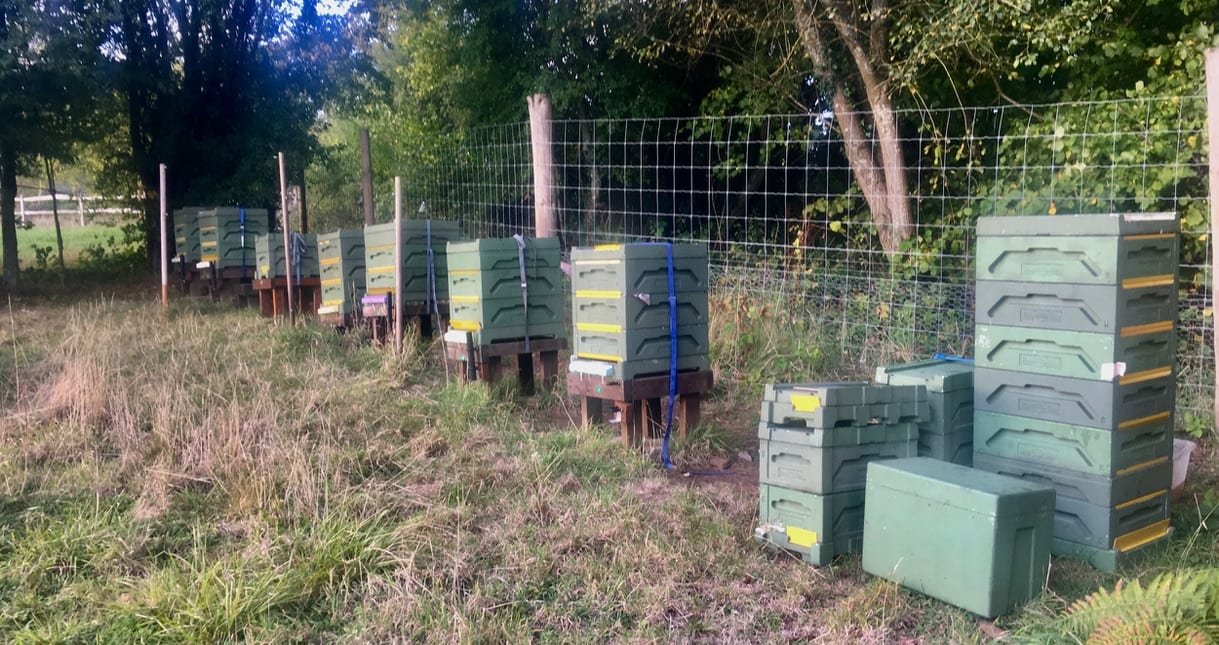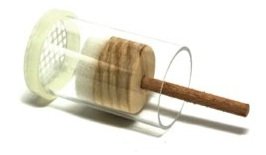
Queen cells
Short version
Wombs where queens grow
Development Finding QC Queen marking Interpreting QC Supersedure Swarming Emergency Summary
When a beekeeper inspects their bees, detecting queen cells is always on their mind. A chief reason is that queen cells can signify that the colony is about to swarm. If they swarm, the beekeeper will wave goodbye to 50-75% of the bees, the queen, and a honey crop.
The queen (Q) larva or pupa, combined with the wall surrounding her, is called a Queen cell (QC). All types of cells look much the same (as unshelled peanuts) but are produced for different purposes.
A frame containing multiple queen cells
The colony makes QC for three reasons:
Supersedure — for queen replacement
Swarm — to reproduce
Emergency — because the queen is lost
Queen cups
Some eggs destined to be queens are laid in queen cups/play cups (PC). Play cups have nothing to do with having fun. They look like small acorn cups.
When inspecting a colony check every cup. If one contains an egg, beware.
Queen cell development
When fertilised eggs “hatch”, the larvae can become queens or workers. Special feeding makes a larva grow into a Q. This food is called royal jelly. It is a white liquid, and white larvae float on top.
As queen larvae grow, a conical wall surrounds them. On the second day as a larva, the QC is referred to as a QC that is “two days old” or a “day two queen cell.”
-

Day 3
-

Day 4
-

Day 4 small larva
-

Late day 5
Spotting Queen Cups
It isn't easy to see eggs in queen cups., you must shake them off frames containing brood. Unpleasant bees won’t like you.
Shaking frames
Basic assessment: demonstrate how to shake bees from the comb
Shake by holding the frame obliquely across the hive, close to the top of the frames so that the bottom bar of the frame ends up one or two inches away after the descent. Barely any bees spill off the hive's top. A queen generally falls off the frame with a small shake.
Standard advice is that bees should be brushed, not shaken off a frame containing QC to avoid disrupting the queen’s wing development or detaching a larva from the base of its cell.
Marking the queen
Finding a marked queen in a large colony is tricky. But it's MUCH more straightforward than finding an unmarked queen. With dark bees, white and yellow are the most visible colours. Marking pens come in other colours, which can be used to signify the age of the queen.
There are devices to help with marking.
A syringe device (video). Watch out if you buy one, as many manufacturers make the holes in the mesh too small.
A cage of thorns (video on Facebook).
There is a one-handed device that I can not recommend. It isn't easy to see where the end is relative to the queen.
Techniques to help find the queen and mark her (good YouTube video)
A device sold by Paynes
Interpreting Queen cells
A day one/two and two/three QC. It is more reliable to assess the size of the larva than the size of the cell. One QC has been broken open, and three bees are cleaning it. Bees that look blackish are referred to as “dark” bees. @ Crown copyright
Supersedure
Supersedure usually takes place in the autumn, occasionally at any other time. The colony does this when the pheromonal balance indicates that the (old, failing or infirm) queen should be replaced. Only 1 to 3 QC are produced; if the cells are much the same age, you can feel pretty confident.
As a rule, at least one QC is on the centre of a frame. It is incredible how a colony can count up to three!
Generally, the old queen dies before or soon after the new queen gets laying; this is called imperfect supersedure. The mother Q and daughter occasionally work together until the daughter takes over in autumn or spring, which is called perfect supersedure.
Swarm cells
Multiple QC are present.
A Q should still be present if all the QCs are open, but she may have flown the nest if even one cell is closed. If there are plenty of bees, do something before she swarms. Do a manipulation.
Emergency
In their urgency, they raise QC from day five brood.
QCs on the face of the comb resemble human noses as only 2/3 of the QC is outside the enlarged worker cell (they cannot use PC). So, the QCs appear small.
Managing QC is pivotal to keeping bees
Emergency QC
Workers have broken down two QC.
When a queen emerges, the tip of her cell often swings up like a trap door.
What to do if you can’t see the queen and there are plenty of bees in the hive
There are two possibilities in this situation: you can not find her, or she is not there! The presence or absence of eggs does not help, as the queen may have died in the last three days. If the queen is marked, it is easier to be certain she has disappeared; if so, do nothing.
Summary
If the queen is present and there are more than three QC, they are swarming.
If the queen is absent, it is an emergency.
“Where have all the bees gone?”= swarmed — leave one queen cell and destroy the rest.
If many queens have emerged, either release one queen and destroy the rest, or release all the queens.
If there are three QCs or less = supersedure, leave them to get on with it.
The most likely cause of QC is swarming.
For a summary about managing queen cells, look at the page about manipulations.
Brood times
Basic assessment: able to state the periods spent by the female castes and drones in the four periods of their development.
Knowing the timing of brood development is vital. You need this to be a sleuth to interpret what you see on the comb.
The numbers on each block represent days. The figures on the left represent the days they live as eggs and larvae, while the blocks on the right represent the number of days spent pupating as sealed brood.
All castes spend three days as an egg.
Next up, the good side of swarming - catching one.
Page 3 - short










